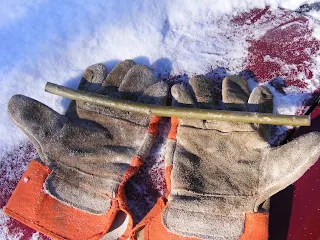 |
| Trigger sticks shown as part "b" and "a". |
---Alert--- TRIGGER WARNING ---Alert---
Few things are as frustrating as being given instructions that are perfectly transparent to the person giving the instructions but are totally opaque to the person trying to execute those instructions.
How often have you been in the engine room when the bridge commanded, "Scotty, defibrillate the Henley-Gonculator, but only after you put it in FM-beta mode." It is likely that you were not able to hear or process anything else the bridge commanded after that.
Triggers
Adding a tensioning feature to your snare decreases the likelihood of your prey chewing through the line or working their way off. The tensioning feature can be a spring pole or a suspended weight like a hunk of wood or a jug filled with water. The use of a tensioning feature requires a trigger.
Sadly, most people who write about these things either believe that you (the reader) learned how to make a trigger at your pappy's knee. Either that or they dodge the question or they present some Rube Goldberg device that leaves you mystified...How are you supposed to whip out one of those when you don't have access to a milling machine when you are lost in the Canadian wilderness?
A simple trigger
 |
| A stick. Gloves for scale. Hood of truck is optional. |
 |
| Rocking the knife back-and-forth quickly sinks it into the soft wood. This is a time when a pair of by-pass pruning shears is worth their weight in gold. |
 |
| I pulled out the blade and then used it to shave the more tapered part of the notch. The bud is immediately above my thumbnail. |
 |
| Quite by accident, you can see the chips of wood I shaved out of the bottom of the notch. |
In a similar way, attaching the line from the spring pole (or weight) above the notch decreases the risk of false triggers. The higher above the notch the more the system is desensitized.
The expectation is that you will leave the sticks long as you fabricate them but them trim them at the site to fit the application.
The picture in my head is that the woodsman can prefabricate five or ten of these triggers in as many minutes. Then carrying them around in his/her back pocket to set up snares as opportunities arise.
This is just one way to make a trigger stick. Your native materials and the tools you have at hand will influence how you execute the details.





Joe! Best Christmas present in many many years came today when the woodpile crept told me you were BACK. Thanks. From Wyoming, the state.
ReplyDelete